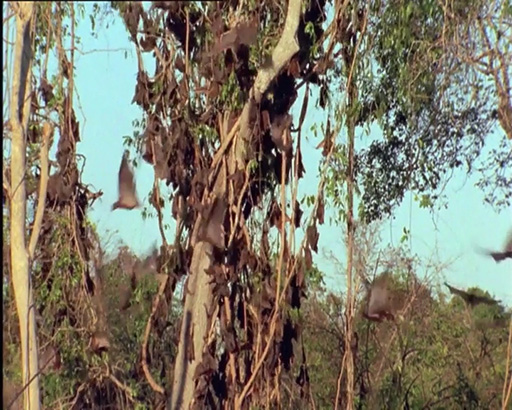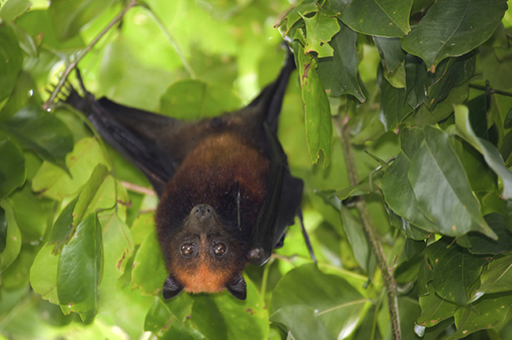4.3 Flying foxes
Many species of flying fox (fruit bat) have important roles in ecosystems, dispersing seeds, pollinating flowers or providing food for predators. As they have evolved not only have they acquired adaptations that enable them to exploit aerial and forest habitats, but they have also evolved alongside plants in a process called co-evolution.
What are the likely advantages to flying foxes of their particular form of roosting, taking into account vulnerability to predators, the location of food and temperature regulation?

Transcript
Watching flying foxes
Colonies of flying foxes may comprise as many as a few million individuals (five million is David Attenborough’s estimate), each with a wingspan of about 1.4 m, with the entire ‘camp’ perched on often denuded trees and engaged in intense social activity.
It’s little wonder that witnessing such a site has been described as a ‘memorable auditory and olfactory experience’. Such concentrations of flying foxes are ‘visible, audible and smellable for miles’ and therefore inevitably attract predators. But congregations of this type may decrease the likelihood of any one individual falling prey to predators, such as eagles. Communication between members of the camp may also increase the efficiency of locating suitable food. But the fact that food sources are depleted so comprehensively when visited en masse raises questions as to the degree of benefit of group living.
Another possible benefit of roosting is that foliage might be protective, shading these mammals from wind, rain and sun, though trees that become camps lose many of their leaves. Fruit bats, for instance, regulate their body temperature, partly by behavioural means. Huddling together in groups should in theory reduce the rate of heat loss in cooler conditions, and decrease the rate of warming when it’s very hot. In both circumstances, the surface area that each individual exposes is lessened by contact.
As you saw in the video, eagles (and owls) take a toll of flying foxes in transit, and the largely nocturnal habit of these species once again probably reflects selection pressure of this type. Flying foxes living on islands (more than 60 per cent of species do so) tend to venture forth in the daylight and in such environments predators are often less evident. Flying foxes can devastate crops, but they can also maintain ‘the fertility of the rain forest’. Flying foxes can certainly help disperse trees by transporting their seeds to new locations, either through their messy eating of fruits or by seeds passing intact through the gut. The seeds of the commercially important West African iroko tree depend on the straw-coloured flying fox for their dispersal. Flying foxes also help in the recolonization of deforested areas and in the establishment of plants on land newly formed or recently devastated by volcanic eruption.
Flying foxes are also important pollinators; many island species occupy the ecological niches taken over elsewhere by insects or hummingbirds, for example. The transfer of pollen from one flower to another on a different tree (i.e. cross-pollination) can confer a significant advantage to the species because it promotes genetic diversity of the next generation. So, the development of mechanisms that promote cross-pollination are very advantageous to trees. In Australia, pollination of some eucalyptus species depends almost entirely on visits from flying foxes. The flowering process of the kampong tree from Malaysia is intimately geared to the feeding habits of the dawn bat. Its flowers open just two hours or so after dusk and drop before dawn, coincident with the bat’s feeding time. The size and shape of the flower opening ensure that only the dawn bat can enter; as its long tongue reaches down to access the nectar, the position of the pollen-producing parts of the flower (the stamens) is such that pollen is deposited on the animal’s fur.
This is a further demonstration of the way in which the evolution of one species can increase its dependence on another, often reflecting some form of mutual advantage. This phenomenon is known as coevolution.

